Ilka Gedő
.jpg)
Ilka Gedő (26 May 1921 — 19 June 1985) was a Hungarian painter and graphic artist. Upon graduation from high school she studied art with private teachers. After the German occupation, she was deported to the Budapest Ghetto, in autumn 1944. In the ghetto she depicted daily life in many drawings. She evaded deportation and a community elder was sent in her place. After liberation she continued her art studies under the Hungarian Bauhaus artist Gyula Pap.
" Although from her early youth onwards Ilka Gedő had close contact with contemporary artists, historians of art, writers and philosophers, her universally significant artistic oeuvre is unparalleled. This may be why her work is still largely unexplored. Ilka Gedő's oeuvre is not simply a variation of contemporary artistic gestures, if it were, the possible analogies would undoubtedly help in its interpretation. Her oeuvre is off the mainstream, it deviates from it and it has the traits of an outsider and, as such, it is an irritation -- the 1946-1949 self-portrait series, for example, is definitely an irritation within Hungarian art. At the same time, however, this art is not a pronounced innovation that would provoke the desire for analysis because of its newsworthiness, it is the result of an absolutely conscious synthesis. The oil paintings from the period between 1970 and 1985 capture the tension between intellectual and emotional aspects and are both unprecedented and without peer in Hungarian painting." [1]
Career
Ilka Gedő was born on 26 May 1921 in Budapest. Her father taught at the Jewish grammar school of Budapest, and some of the leading Hungarian writers and artists of the times were among the family’s circle of friends. She started her artistic career in the late 1930s visiting private art schools.
The anti-Jewish measures and the upheaval of the war came, but Gedő carried on creating a significant body of graphic works. As a Jew, in 1944 Gedő was imprisoned in the Budapest ghetto, and she drew a remarkable series of ghetto drawings. She avoided the horror, instead representing isolated people of puzzlement, uncertainty and despair in her drawings.
After the war Gedő gained admission to the Budapest Academy of Arts, but she decided to leave the Academy and until 1949, when she stopped artistic work, had created a huge body of drawings that can be divided into series.
She created self-portraits which, through their sheer honesty and self-exploration, claim the viewer’s attention. These works are drawn in a way that evokes straightforward physical reality and emotional sensitivity at the same time. Another series, Tables, is devoted to drawing a delicate, small table with an abundant variety of lines and shades, exploring the endless possibilities of representing the visual world.

The third series resulted from repeated visits to the Ganz Factory in Budapest. “The Ganz Factory, situated at the Margit körút in Budapest, was a large enterprise producing elements for electrical engineering in one plant, and metal parts for machines and tools in another plant. In the late 1940’s, after the war, it offered an educational program, organised by a liberally minded engineer. Ilka Gedő was welcome on the premises to sit and draw, even if the result did not correspond to the official image of the worker.”[2] A combination of silver and gold with pastel crayons transposes the factory rooms into almost mythical spaces.
An interval of 15 years devoted to bringing up a family divides the oeuvre of this artist. Ilka Gedő presented her drawings in 1964 in her own studio. This exhibition gave her the impetus to resume work. In the 1960s, Gedő started to paint in oil. Her creative method follows the call of the instincts but does not forget the discipline of the intellect. „Art critics have been quick to point out evidence of her nostalgia for Art Nouveau and Jugendstil. However, Gedő’s real nostalgia is for a lost mythology, and in this she is similar to her fin-de-siècle predecessors. She found this mythology, albeit a personal one, in art, which is capable of evoking and cherishing the memories of an endangered world.” [3]
She made “two-step” paintings. She first drew a sketch of her composition, prepared a mock-up and wrote the name of the appropriate colours into the various fields. She prepared a collection of colour samples, and she wrote where the colour would go in the places where they were ultimately applied. She never improvised on her paintings; instead she enlarged the original plan. On her paintings the strength of cold and warm colours appears to be equal. She created her paintings slowly, amidst speculations, recording the steps of the creative process in diaries so that the making of all the paintings can be traced.
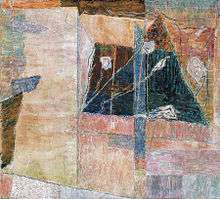
Gedő died on 19 June 1985, at the age of 64, a few months before her discovery abroad. The scene of the breakthrough was Glasgow where the Compass Gallery presented her paintings and drawings in 1985. Since then, many of her works passed into public hands: in addition to the St. Stephen’s Museum, Székesfehérvár, Hungary and the Hungarian National Gallery, many foreign collections acquired them /The Jewish Museum (New York), the Yad Vashem Art Museum, the Israel Museum (Jerusalem), the Department of Prints and of the British Museum, the Museum Kunstpalast of Düsseldorf, the Berlin Kupferstichkabinett (Museum of Prints and Drawings), the Graphic Arts Collection of the Albertina and the Metropolitan Museum/.
Chronology
- 1921 Ilka Gedő was born on 26 May 1921 in Budapest. Her father was a teacher at the Budapest Jewish Grammar School. The mother, Elsa Weiszkopf, was a clerk.
- 1939 In autumn Ilka Gedő visits the free school of Tibor Gallé.
- 1940 She participates in the second exhibition of OMIKE (Hungarian National Cultural Society of Jews).
- 1939-42 Due to family connections she receives training from Erdei Viktor.
- 1942 She takes part in the exhibition organised by the Group of Socialist Painters that takes place at the Centre of the Metal Workers' Union.
- 1942-43 She attends the free school of István Örkényi-Strasser.
- 1943 Gedő participates in fifth exhibition of OMIKE in the exhibition halls of the Hungarian Jewish Museum.
- 1944 In the Budapest ghetto a huge series of drawings is born.
- 1945 In the autumn of 1945 Ilka Gedő enrols as a full-time student in the Academy of Fine Arts. However, she leaves the academy after six months due to family reasons. She draws at the school of Gyula Pap, a former member of Bauhaus.
- 1946 She marries the biochemist Endre Bíró.
- 1947 She takes part in the Second Open National Exhibition of the Trade Union of Hungarian Artists. Birth of her first son.
- 1949 She stops her artistic activities only to resume them in 1965.
- 1950 From 1950 on she does not take part in art life. Her interests turn to the philosophy of art and art history. She translates extensive passages from Goethe’s theory of colour.
- 1953 Birth of her second son.
- 1962 The National Gallery of Hungary buys three drawings of the artist.
- 1965 Gedő shows a selection of her drawings from the years 1945-1949 in a studio exhibition. She resumes her artistic activities.
- 1969-1970 Spends a year in Paris. She participates in a group museum exhibition of the Galerie Lambert.
- 1974 She gains admission to the Association of Visual Artists.
- 1980 Retrospective exhibition in the St. Stephen’s Museum of Székesfehérvár, Hungary.
- 1982 Exhibition at the Dorottya Gallery of Budapest. The National Gallery of Hungary buys two of the artist’s paintings.
- 1985 Gedő dies on 19 June in Budapest. A solo exhibition of the artist is opened in the Gallery of the Szentendre Art Colony. A solo exhibition of Gedő is organized in the framework of the Hungarian Season in Glasgow. Gedő’s art is praised by the art critics of the Glasgow Herald, The Scotsman, Financial Times, The Times, Daily Telegraph, The Observer and The Guardian
- 1987 Gedő’s largest Hungarian exhibition takes place in the Budapest exhibition venue, Műcsarnok.
- 1989 Exhibition at the Municipal Art Gallery of Szombathely, Hungary.
- 1989-1990 Gedő’s second Glasgow exhibition takes place between 9 December 1989 and 12 January 1990 at the Third Eye Centre (346-354 Sauchiehall Street).
- 1994 Solo exhibition at New York’s Janos Gat Gallery.
- 1995 An exhibition titled Victims and Perpetrators from the drawings of György Román made during the trial of Hungarian war criminals and Gedő’s drawings made in 1944 in the Budapest ghetto takes place at the Budapest Jewish Museum. From April 1995 four of Ilka Gedő’s drawings are shown at the exhibition titled Culture and Continuity: the Jewish Journey of the New York Jewish Museum for a period of six months. The Shepherd Gallery in New York City organizes an exhibition from Gedő’s drawings including the table series, the self-portraits and the Ganz factory drawings from 21 November to 19 December 1995.
- 1996 Supplemented by three oil paintings of both Gedő and Román, Victims and Perpetrators is shown at the Art Museum of Yad Vashem.
- 1997 Solo exhibition at the Janos Gat Gallery in New York City.
- 1998 The Department of Prints and Drawings of The British Museum acquires 15 and The Israel Museum acquires six drawings by Ilka Gedő.
- 1999 Participation in the collective exhibition titled Voices From Here and There (New Acquisitions in the Department of Prints and Drawings) of the Israel Museum. The Düsseldorf Museum Museums Kunst Palast acquires ten drawings of the Artist.
- 2001 Chamber exhibition of Gedő’s drawings at the Budapest Municipal Picture Gallery and Kiscelli Museum. The National Gallery buys three of Gedő’s paintings.
- 2002 Two of Gedő’s painting become a part of the permanent exhibition of the National Gallery.
- 2003 Gondolat Kiadó, a Budapest publishing house publishes in English and Hungarian an album titled The Art of Ilka Gedő (1921–1985) / Oeuvre Catalogue and Documents. The sons of the artist donate twenty-three drawings and three paintings of Gedő to the Hungarian National Gallery.
- 2004 Oeuvre exhibition at the National Gallery of Hungary from 18 November 2004 to 3 April 2005.
- 2006 Exhibition of Ilka Gedő takes place at the Berliner Collegicum Hungaricum from 9 March to 10 May. A representative selection of the artist’s drawings and paintings is shown from the permanent collections of the Hungarian National Gallery and the Düsseldorf Museum Kunst Palast.
- 2011 The Kupferstichkabinett (Museum of Prints and Drawings, Berlin) acquires eight drawings of Ilka Gedő.
- 2013 The Albertina acquires twelve drawings of Ilka Gedő.
- 2013 Chamber Exhibition of Ilka Gedő at the National Theatre of Hungary from 22 March to 23 April 2013.
- 2014 The joint exhibition of the Israel Museum and the Hungarian National Gallery titled Dada and Surrealism/ Rearranged Reality from 9 July to 5 October features three oil paintings and three works on paper by Ilka Gedő.
- 2015 The Department of Modern and Contemporary Art of the New York Metropolitan Museum of Art acquires three drawings of the artist. The Museum of Fine Arts, Houston acquires eight self-portrait drawings by Ilka Gedő.
- 2016 The Herzog Anton Ulrich Museum in Braunschweig, which heavily focusses on the collection of self-portraits, acquires a representative collection of twenty-one self-portrait drawings by Ilka Gedő.
Exhibitions
One-woman exhibitions in Hungary:
- Studio Exhibition (1965)
- King St. Stephen's Museum, Székesfehérvár, Hungary (1980)
- Dorottya Utca Gallery, Budapest (1982)
- Artists' Colony Gallery, Szentendre, Hungary (1985)
- Palace of Exhibitions, Budapest (1987)
- Gallery of Szombathely (1989)
- Hungarian Jewish Museum, Budapest, [with György Román] (1995)
- Budapest Municipal Picture Gallery, Museum Kiscell (2001)
- Raiffeisen Gallery (2003–2004)
- Hungarian National Gallery (2004–2005).
One-woman exhibitions abroad:
- Compass Gallery, Glasgow (1985)
- Third Eye Centre, Glasgow (1989)
- Janos Gat Gallery, New York (1994 and 1997)
- Yad Vashem Art Museum [with György Román] 1996
- Shepherd Gallery, New York (1995)
- Collegium Hungaricum, Berlin (2006)
Works in public collections
- The Hungarian National Gallery, Budapest
- The Hungarian Jewish Museum, Budapest
- The King St. Stephen's Museum, Székesfehérvár, Hungary
- The Yad Vashem Art Museum, Jerusalem
- The Israel Museum, Jerusalem
- The British Museum, Department of Prints and Drawings
- The Museum Kunst Palast, Düsseldorf, Department of Prints and Drawings
- The Jewish Museum, New York
- The Kupferstichkabinett (Museum of Prints and Drawings), Berlin
- The Albright-Knox Art Gallery, Buffalo, New York, USA
- The Museum of Fine Arts, Houston, Texas, USA
- The Albertina, Vienna
- The Metropolitan Museum of Art (Department of Modern and Contemporary Art), New York
- The Duke Anton Ulrich Museum, Braunschweig
Literature
• Szabó, Júlia (ed.): Gedő Ilka rajzai és festményei (The Drawings and Paintings of Ilka Gedő), exhibition catalogue, Székesfehérvár, Szent István Király Múzeum, 1980, HU ISBN 963-7131-20-5 HU ISSN 0586-3759
• Ury, Ibolya (ed.): Gedő Ilka, kiállításkatalógus (Ilka Gedő, Exhibition Catalogue), Budapest, a Műcsarnok Dorottya utcai Kiállítóterme, 1982, HU ISBN 963-01-4173-6
• Mucsi, András (ed.): Gedő Ilka (1921–1985) festőművész kiállítása (The Exhibition of Ilka Gedő /1921-1985/), exhibition catalogue, Szentendre, Művésztelepi Galéria, 1985, HU 963-01-6605-4 ISSN 0209-4940
• Néray, Katalin (ed.): Gedő Ilka (1921–1985), exhibition catalogue, Budapest, Palace of Exhibitions, 1987, ISBN 963-7162-86-0
• Gálig, Zoltán (ed): Gedő Ilka festőművész rajzai a Szombathelyi Képtárban (Works on Paper by Ilka Gedő at the Municipal Art Museum of Szombathely), Szombathely, Városi Képtár, 1989, ISBN 963-01-9554-2 ISSN 0239-1910
• Semjén, Anita (ed): Áldozatok és gyilkosok / Gedő Ilka gettó-rajzai és Román György háborús bűnösök népbírósági tárgyalásain készült rajzai (Victims and Perpetrators / Ilka Gedő's Ghetto Drawings and György Román's Drawings of the People's Court War Criminals Trials), exhibition catalogue, Budapest, 1995, Hungarian Jewish Museum and Jerusalem, 1996, Yad Vashem Art Museum
• Kashey, Elizabeth (ed): Ilka Gedő (1921–1985) Drawings and Pastels, exhibition catalogue, New York, Shepherd Gallery, 21 East 84th Street, 1995, OCLC 313759285
• Kolozsváry, Marianna (ed.): Gedő Ilka festőművész kiállítása (Exhibition of Ilka Gedő), exhibition catalogue, Budapest, Hungarian National Gallery, 2004, HU ISSN 0231-2387
• György, Péter–Pataki, Gábor, Szabó, Júlia, Mészáros, F. István: Gedő Ilka művészete (1921–1985) – The Art of Ilka Gedő (1921–1985), Budapest, Új Művészet, 1997, ISBN 963-7792-21-X ISSN 1219-4913
• Hajdu, István–Bíró, Dávid: Gedő Ilka művészete, oeuvre katalógus és dokumentumok, Gondolat Kiadó, Budapest, 2003 ISBN 963-9500-13-5
• István Hajdu–Dávid Bíró: The Art of Ilka Gedő, Oeuvre Catalogue and Documents, Gondolat Kiadó, Budapest, 2003 ISBN 963-9500-14-3
External links
- The Complete Works of Ilka Gedő (1921-1985): Digitised Catalogue Raisonne
- The Complete Works of Ilka Gedő (1921-1985): Digitised Catalogue Raisonne. Gedő Ilka (1921-1985) minden munkája: digitalizált oeuvre katalógus
- Works by Ilka Gedő at the British Museum
- Works by Ilka Gedő at the Metropolitan Museum
- Works on paper by Ilka Gedő at the Albertina can be viewed by writing the name of the artist into the field:
- Works on paper by Ilka Gedő at the Museum of Fine Arts, Houston
- Oil paintings by Ilka Gedő at the Hungarian National Gallery:
- Works of Ilka Gedő held by Yad Vashem Art Museum (a selection):
- Ilka Gedő - The Painter and Her Work / A Background Report, Magyar Elektronikus Könyvtár, Budapest, 2014
Oil Paintings at the Hungarian National Gallery
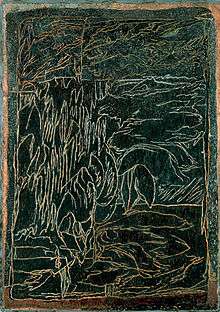
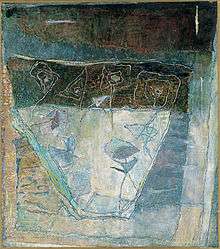


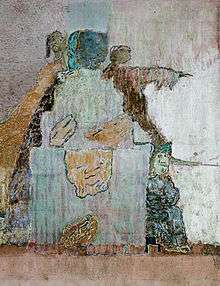

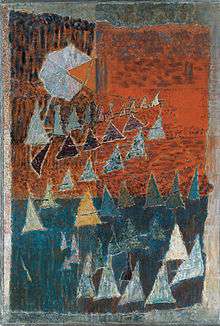

|
- ↑ István Hajdu : Half Picture, Half Veil - the Art of Ilka Gedő In: István Hajdu - Dávid Bíró The Art of Ilka Gedő (1921-1985) Oeuvre Catalogue and Documents, Gondolat Kiadó, Budapest, 2003, p. 6
- ↑ Elisabeth Kashey (Ed.): Ilka Gedő (1921–1985) Drawings and Pastels, exhibition catalogue, Shepherd Gallery, New York, 1995, p. 19 OCLC 313759285
- ↑ Contemporary Visual Art in Hungary : Eighteen Artists [edited and designed by Christopher Carrel ; exhibition selection Paul Overy, Christopher Carrell, in association with Márta Kovalovszky], Third Eye Centre in association with the King Stephen Museum, Glasgow, 1985, p. 42, ISBN 0906474507